POJ_2446_Chessboard(二分图匹配)
来源:互联网 发布:制作pdf的软件 编辑:程序博客网 时间:2024/05/16 19:32
Chessboard
Time Limit: 2000MS Memory Limit: 65536KTotal Submissions: 14479 Accepted: 4501
Description
Alice and Bob often play games on chessboard. One day, Alice draws a board with size M * N. She wants Bob to use a lot of cards with size 1 * 2 to cover the board. However, she thinks it too easy to bob, so she makes some holes on the board (as shown in the figure below).
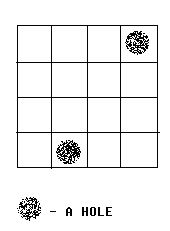
We call a grid, which doesn’t contain a hole, a normal grid. Bob has to follow the rules below:
1. Any normal grid should be covered with exactly one card.
2. One card should cover exactly 2 normal adjacent grids.
Some examples are given in the figures below:
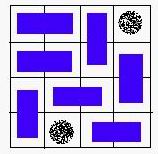
A VALID solution.
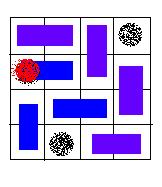
An invalid solution, because the hole of red color is covered with a card.
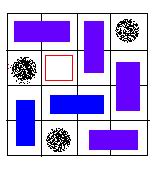
An invalid solution, because there exists a grid, which is not covered.
Your task is to help Bob to decide whether or not the chessboard can be covered according to the rules above.

We call a grid, which doesn’t contain a hole, a normal grid. Bob has to follow the rules below:
1. Any normal grid should be covered with exactly one card.
2. One card should cover exactly 2 normal adjacent grids.
Some examples are given in the figures below:

A VALID solution.

An invalid solution, because the hole of red color is covered with a card.

An invalid solution, because there exists a grid, which is not covered.
Your task is to help Bob to decide whether or not the chessboard can be covered according to the rules above.
Input
There are 3 integers in the first line: m, n, k (0 < m, n <= 32, 0 <= K < m * n), the number of rows, column and holes. In the next k lines, there is a pair of integers (x, y) in each line, which represents a hole in the y-th row, the x-th column.
Output
If the board can be covered, output "YES". Otherwise, output "NO".
Sample Input
4 3 22 13 3
Sample Output
YES
Hint
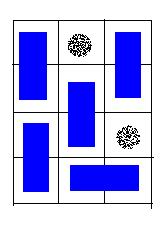
A possible solution for the sample input.
题意:给出一个矩形N*M棋盘,有K个格子是空洞,然后用2*1的矩形,对所有非空洞的格子进行覆盖,问能否完全覆盖。
分析:二分图匹配问题。关键问题是如何建图,我们可以把每两个相邻的非空格子用一条边连接起来,这样的话相当于这两个格子处于分别处于两个集合当中,这样的话两个相邻的格子就不会处于同一个集合当中。然后这样子连边就构成了一个二分图了。然后求出最大匹配数。如果匹配数 + k = N*M,输出“YES”。
题目链接:http://poj.org/problem?id=2446
代码清单:
#include<map>#include<queue>#include<cmath>#include<stack>#include<ctime>#include<cctype>#include<string>#include<cstdio>#include<cstring>#include<iostream>#include<algorithm>using namespace std;typedef long long ll;const int maxn = 32 + 5;const int maxv = 2000 + 5;int m,n,k;int x,y,cnt;int match[maxv];bool vis[maxv];int num[maxn][maxn];bool hole[maxn][maxn];bool graph[maxv][maxv];bool dfs(int u){ //匈牙利算法 for(int v=1;v<=cnt;v++){ if(!vis[v]&&graph[u][v]){ vis[v]=true; if(match[v]==-1 || dfs(match[v])){ match[v]=u; return true; } } }return false;}bool ok(){ int ans=0; for(int i=1;i<=cnt;i++){ memset(vis,false,sizeof(vis)); if(dfs(i)) ans++; } if(ans==cnt) return true; return false;}int main(){ scanf("%d%d%d",&m,&n,&k); memset(match,-1,sizeof(match)); memset(hole,false,sizeof(hole)); memset(graph,false,sizeof(graph)); for(int i=0;i<k;i++){ scanf("%d%d",&x,&y); hole[y-1][x-1]=true; } if((n*m-k)&1) printf("NO\n"); //奇偶性剪枝 else{ cnt=0; for(int i=0;i<m;i++){ for(int j=0;j<n;j++){ if(!hole[i][j]) num[i][j]=++cnt; } } //建立二分图 for(int i=0;i<m;i++){ for(int j=0;j<n;j++){ if(!hole[i][j]){ if(i-1>=0&&!hole[i-1][j]) graph[num[i][j]][num[i-1][j]]=true; if(i+1<m&&!hole[i+1][j]) graph[num[i][j]][num[i+1][j]]=true; if(j-1>=0&&!hole[i][j-1]) graph[num[i][j]][num[i][j-1]]=true; if(j+1<n&&!hole[i][j+1]) graph[num[i][j]][num[i][j+1]]=true; } } } if(ok()) printf("YES\n"); else printf("NO\n"); } return 0;} 0 0
- POJ_2446_Chessboard(二分图匹配)
- POJ_2446_Chessboard
- 二分图图匹配
- 二分图匹配
- 二分图匹配
- 二分图匹配
- 二分图匹配
- 正则二分图匹配
- 二分图匹配
- 二分图匹配总结
- 二分图最大匹配
- 二分图最大匹配 。
- hdu2119二分图匹配
- 二分图匹配
- 二分图匹配
- 二分图匹配算法
- poj3020-二分图匹配
- 二分图匹配
- udig+postgresql
- unix网络编程卷一: 第八章:简单UDP客户端服务器通信(一)
- Ibaits操作二进制数据的一些小技巧
- mkdir命令
- Linux进程间通信——命名管道
- POJ_2446_Chessboard(二分图匹配)
- 使用spring @Scheduled注解执行定时任务
- MySQL第二天早上第一次连接超时报错,解决方法com.mysql.jdbc.exceptions.jdbc4.CommunicationsException
- 表达式的使用
- (五)Linux网络编程--5. 用户数据报发送
- 三种经典博弈问题
- 做了两个1~24V 可调电源。USB充电。
- (六)Linux网络编程--6. 高级套接字函数
- 国家统计标准(包括行政区划、行业类别等实用信息)


